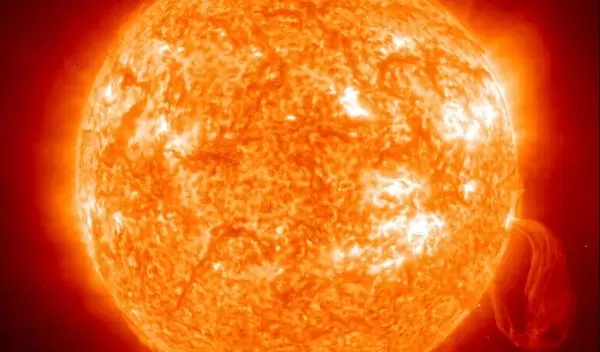
Scientists Listen to Song of the Sun
To most of us, the sun seems to dangle in space silently without making so much as a peep. Nevertheless, "the sun is a very noisy place," said Scott McIntosh of the National Science Foundation (NSF)-supported National Center for Atmospheric Research.
What does the sun sound like? As best as we can tell, the sun sounds like a low hum punctuated by frequent rhythmic, bass-y thumps.
How does the sun generate its sound? Composed of gases, the sun's core contains a giant nuclear fusion factory, where hydrogen is pressed into helium at temperatures of about 27,000,000° Fahrenheit (15,000,000° Celsius). The energy of this nuclear fusion factory generates convection that reaches all the way to the sun's surface.
The convection follows regions, or cells, and is driven by gas that roils and boils, similar to the boiling of water in a pot. The motion of the gas within the convection cells changes the light waves emitted by the surface of the sun.
Scientists measure the changing light waves using an instrument called a dopplergraph that is mounted on a spacecraft called the Solar and Heliospheric Observatory (SOHO). The measured light changes are translated into motion (sound) waves by computer models that capture the relationships between light waves and sound waves.
Because the resulting sound waves are at a frequency too low to be heard by humans, the signals are sped up to become audible. The result: an inferred composite of solar sound waves that includes "all kinds of frequencies," McIntosh said.
The sun's serenade can only be inferred because there is no air in the 93 million miles of space between the Earth and sun. And since sound cannot travel through a vacuum, the sun cannot be directly heard from Earth.
McIntosh compares the multi-frequency song of the sun to the ringing of cathedral bells that each hit different notes. Just as cathedral bells get louder and chime out certain pitches when certain bells are simultaneously rung, the sun belts out rhythmic bass thumps over its background hum when certain frequencies overlap with one another.
The relatively recent discovery and understanding of the sun's waves are enabling scientists to, for the first time, go under the surface and actually "see" inside the sun.
How? With the help of the dopplergraph, which is used to track the time taken by certain waves to travel through the sun and back--similar to the way that seismographs are used to track waves of energy traveling below and along the Earth's surface (in order to help scientists detect earthquakes).
From the dopplergraph measurements, scientists can deduce the temperature, chemical composition and motions of gases from just below the sun's surface to close to its core. This technique is also being used to investigate the surfaces and interiors of other stars besides the sun.
-- Lily Whiteman, National Science Foundation, lwhitema@nsf.gov
This Behind the Scenes article was provided to LiveScience in partnership with the National Science Foundation.


